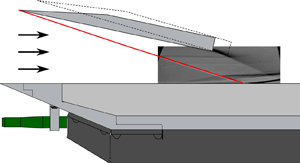Article contents
Hypersonic shock impingement studies on a flat plate: flow separation of laminar boundary layers
Published online by Cambridge University Press: 04 November 2022
Abstract

Interactions between shock waves and boundary layers produce flow separations and augmented pressure/thermal loads in hypersonic flight. This study provides details of Mach 7 impinging-shock-flat-plate experiments conducted in the T4 Stalker Tube. Measurements were taken at flow conditions of Mach 7.0 (2.44 MJ kg $^{-1}$) and Mach 7.7 (2.88 MJ kg
$^{-1}$) and Mach 7.7 (2.88 MJ kg $^{-1}$) flight enthalpies with a range of freestream unit Reynolds numbers from
$^{-1}$) flight enthalpies with a range of freestream unit Reynolds numbers from  $1.43 \times 10^{6}$ m
$1.43 \times 10^{6}$ m $^{-1}$ to
$^{-1}$ to  $5.01 \times 10^{6}$ m
$5.01 \times 10^{6}$ m $^{-1}$. A shock generator at
$^{-1}$. A shock generator at  $12^{\circ }$ or
$12^{\circ }$ or  $16^{\circ }$ to the freestream created an oblique shock which impinged on a boundary layer over a flat plate to induce flow separation. The flow field was examined using simultaneous measurements of wall static pressure, heat transfer and schlieren visualisation. Measured heat transfer along the flat plate without the shock impingement indicated that the boundary layer remained laminar for all flow conditions. The shock impingement flow field was successfully established within the facility test duration. The onset of separation was observed by a rise in wall pressure and a decrease in heat transfer at the location corresponding to the stem of the separation shock. Downstream of this initial rise, an increased pressure and higher heating loads were observed. The heat-transfer levels also indicated an immediate boundary layer transition due to the shock impingement. The separation data of the present work showed good agreement with our previous work on shock impingement on heated walls (Chang et al., J. Fluid Mech., vol. 908, 2021, pp. 1–13). A comparison with the previous scaling indicated that the separation also relates to the pressure ratio and the wall temperature parameter.
$16^{\circ }$ to the freestream created an oblique shock which impinged on a boundary layer over a flat plate to induce flow separation. The flow field was examined using simultaneous measurements of wall static pressure, heat transfer and schlieren visualisation. Measured heat transfer along the flat plate without the shock impingement indicated that the boundary layer remained laminar for all flow conditions. The shock impingement flow field was successfully established within the facility test duration. The onset of separation was observed by a rise in wall pressure and a decrease in heat transfer at the location corresponding to the stem of the separation shock. Downstream of this initial rise, an increased pressure and higher heating loads were observed. The heat-transfer levels also indicated an immediate boundary layer transition due to the shock impingement. The separation data of the present work showed good agreement with our previous work on shock impingement on heated walls (Chang et al., J. Fluid Mech., vol. 908, 2021, pp. 1–13). A comparison with the previous scaling indicated that the separation also relates to the pressure ratio and the wall temperature parameter.
Information
- Type
- JFM Papers
- Information
- Copyright
- © The Author(s), 2022. Published by Cambridge University Press
References
- 12
- Cited by


